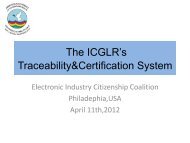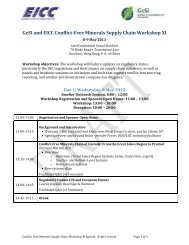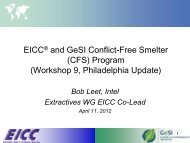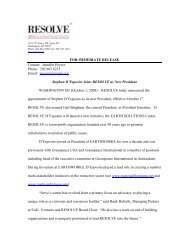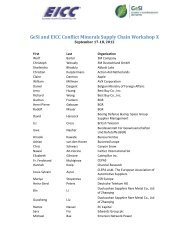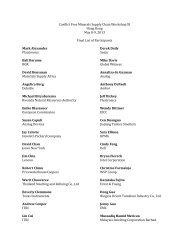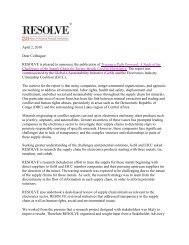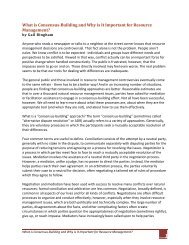Toward SuSTainabiliTy: The roleS and limiTaTionS of ... - Resolve
Toward SuSTainabiliTy: The roleS and limiTaTionS of ... - Resolve
Toward SuSTainabiliTy: The roleS and limiTaTionS of ... - Resolve
Create successful ePaper yourself
Turn your PDF publications into a flip-book with our unique Google optimized e-Paper software.
Chapter 2: Actors – Government 30(USDA) launched national organic st<strong>and</strong>ards,requiring any producer using the word organicto be certified by accredited agencies, includingthe CCOF. 1 <strong>The</strong> USDA st<strong>and</strong>ards differ from theoriginal CCOF st<strong>and</strong>ards, <strong>and</strong> some organic proponentsfeel that government involvement at thefederal level weakened the label overall. Othersmaintain that federal involvement has strengthenedthe concept <strong>of</strong> organic labeling by applying alegal framework for using the term organic.Part <strong>of</strong> the reason behind the proliferation<strong>of</strong> certification schemes in the 1990s was theemerging global trends favoring free markets<strong>and</strong> private enterprise over government action(Bartley, 2007b; Bartley, 2010; Bernstein &Cashore, 2007; Cashore, 2002; Cashore, Auld,& Newsom, 2004). This new thinking frustratedefforts to adopt government regulations <strong>and</strong>intergovernmental agreements. <strong>The</strong> development<strong>of</strong> the Forest Stewardship Council (FSC)in 1993—described in Chapter 1 <strong>and</strong> the CivilSociety section <strong>of</strong> this chapter—illustrates thissituation. <strong>The</strong> FSC emerged, in part, from theashes <strong>of</strong> failed efforts to agree to a binding internationalforestry convention. <strong>The</strong> program cametogether when concerned industry players, seekingto distinguish their product, joined forces withnongovernmental organizations (NGOs) suchas the World Wide Fund for Nature (WWF) <strong>and</strong>the Rainforest Action Network (Bartley, 2007b;Cashore, et al., 2004; Meidinger, 2006).Yet as Bartley (2007b) <strong>and</strong> Cashore (2002)note, governments played a crucial role in theFSC’s initial success. Several European cities <strong>and</strong>countries—as well as some American cities <strong>and</strong>states—passed restrictions on the import <strong>of</strong> ecologicallyunsound timber. When Austria’s ban waschallenged by timber-exporting states as a tradebarrier, Austria rescinded the law but redirectedgovernment funds for implementation to thenascent FSC, giving it a substantial boost at a crucialtime. It also encouraged other nations, suchas Switzerl<strong>and</strong> <strong>and</strong> the Netherl<strong>and</strong>s, to providefinancial support to the FSC, in response to publicpressure for action (Bartley, 2007b). <strong>The</strong> FSC alsoreceived a boost when state governments pursuedFSC certification for some <strong>of</strong> their publiclyowned forests. In the United States, for example,Pennsylvania was an early adopter <strong>of</strong> FSC certification,<strong>and</strong> today 2.2 million acres <strong>of</strong> state-ownedforests in Pennsylvania are FSC-certified. 2<strong>The</strong> certification <strong>of</strong> labor practices in theapparel industry also benefited from significantgovernment support <strong>and</strong> funding in the1990s. According to Bartley (2007b), the ClintonAdministration first proposed, <strong>and</strong> then helped toestablish, the Apparel Industry Partnership/FairLabor Association. It also provided vital financialsupport for Social Accountability International’scertification systems in their early years. WhileNGOs played a leading role in developing <strong>and</strong>advancing these schemes, the U.S. federal governmentprovided the initial creative impetus <strong>and</strong>support—even though these certifications aroseas an alternative to binding government action.<strong>The</strong> government <strong>of</strong> China has acted far beyondfunding; like the German government, it hasestablished its own certification schemes. As anexample, China’s Ministry <strong>of</strong> Agriculture (MOA)oversees two certification schemes establishedby the Chinese government during the 1990s—Green Food <strong>and</strong> Hazard Free Food—as well asorganic certification to international st<strong>and</strong>ards.<strong>The</strong> MOA’s China Green Food DevelopmentCentre owns the Green Food logo, develops <strong>and</strong>maintains the st<strong>and</strong>ard, is responsible for certifications,coordinates inspections <strong>and</strong> monitoring,<strong>and</strong> obtains revenue for certification fees. GreenFood certification is a stepping stone towardorganic certification to international st<strong>and</strong>ards,<strong>and</strong> production in all <strong>of</strong> these “eco-categories”has grown tremendously since its inception.Green Food production alone jumped from 6.3million tons in 1997 to 72 million tons in 2007,with export value increasing from $70 million to$2 billion in 2006 (Paull, 2008).1 www.ers.usda.gov/data/organic/.2 www.fscus.org/news/index.php?article=23<strong>Toward</strong> Sustainability: <strong>The</strong> Roles <strong>and</strong> Limitations <strong>of</strong> Certification



